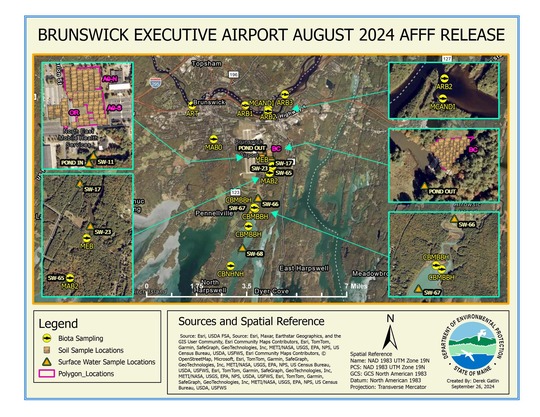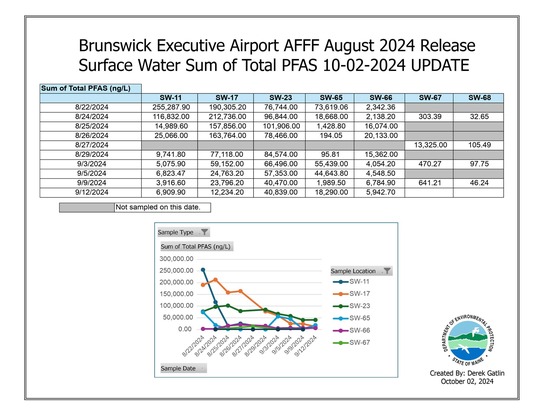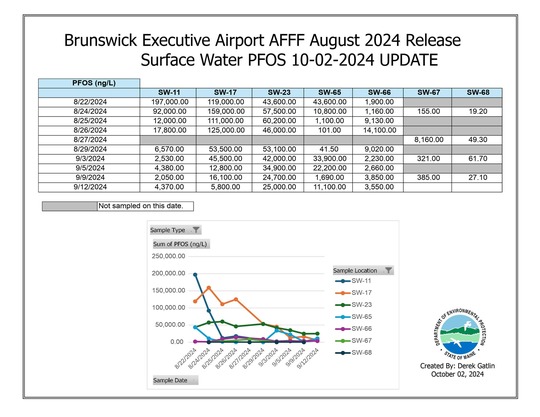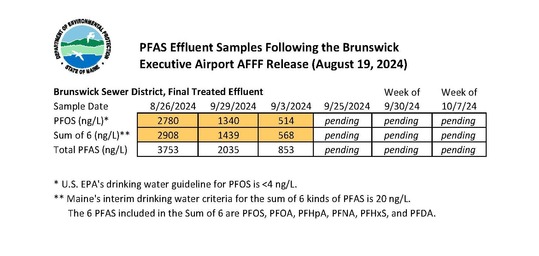Update 12: Sampling effort continues for the former Brunswick Naval Air Station
AUGUSTA, October 3, 2024 — Nine rounds of surface water results from the Merriconeag Stream watershed, documenting conditions following the August AFFF release, have been evaluated by Department staff. Most concentrations continue to decline throughout the watershed, and the highest concentrations are still being detected below the Picnic Pond outflow. Four rounds of data from Harpswell Cove have been received by the Department and indicate contamination has reached the marine environment but is quickly being diluted to low concentrations. PFAS levels in the watershed have not yet returned to pre-spill concentrations and testing of surface water will continue to track the trends.
    Following the August 19, 2024, AFFF spill, AFFF entered the public sanitary sewer system of the Brunswick Sewer District (BSD) and the BSD wastewater treatment facility that discharges to the Androscoggin River. The table below summarizes the results of the BSD effluent samples for PFAS that were taken in response to the spill. Results to date indicate levels of PFAS significantly higher than the BSD long term historical average of 34.2 ng/L (parts per trillion) (for sum of six PFAS in Maine’s interim drinking water standard) obtained in 2022 and 2023 prior to the spill. The recent results also indicate a steady downward trend in effluent PFAS levels over the sampling period since the spill. Additional sample results are pending. Results for PFAS sampling in the Androscoggin River, above and below the BSD effluent discharge outfall, were previously reported and are available on the Department’s Brunswick Naval Air Station AFFF (PFAS) Release web page at https://www.maine.gov/dep/projects/bnas/index.html.
 The Brunswick Executive Airport is part of the former Brunswick Naval Air Station (BNAS) and encompasses roughly 3,100 acres. BNAS is included in the Superfund program’s National Priorities List (NPL). The NPL is established as part of the implementation of the Comprehensive Environmental Response, Compensation, and Liability Act (CERCLA), which is a federal law that gives the U.S. government the authority to respond to hazardous substance releases and threats, and hold responsible parties liable for costs due to those releases. “Superfund” is part of CERCLA.
Former military sites listed on the NPL, like BNAS involve the Federal government through the Federal Facilities and Superfund Program umbrella. This means that there are federal representatives that act as the lead regulator for these sites through the remediation process. In the case of BNAS the federal representatives that act as the lead regulators are the US Environmental Protection Agency (EPA), and the Department of Defense (DoD) Navy.
Maine has a corollary law, the Uncontrolled Sites Act, which gives Maine DEP similar authorities for sites where hazardous substances have been released. In the case of BNAS, DEP works closely with the EPA and DoD, but the DEP is not the lead for this project.
The BNAS remediation process falls under an October 1990 Federal Facilities Agreement (FFA). This agreement establishes the responsibilities of the Navy, U.S. Environmental Protection Agency, and the Maine Department of Environmental Protection in studying contamination at the site and remediating the former base. Under that agreement, the Navy is required to conduct site contaminant investigations and remedial activities.
The Navy is able to sell or lease portions of the former BNAS subject to a Finding of Suitability for the proposed use by the EPA and Maine DEP. This is how the Midcoast Regional Redevelopment Authority (MRRA) became the current operator at the facility.
The next update will be issued as soon as additional test results become available.
For additional information, contact:
David R. Madore, Deputy Commissioner
|
